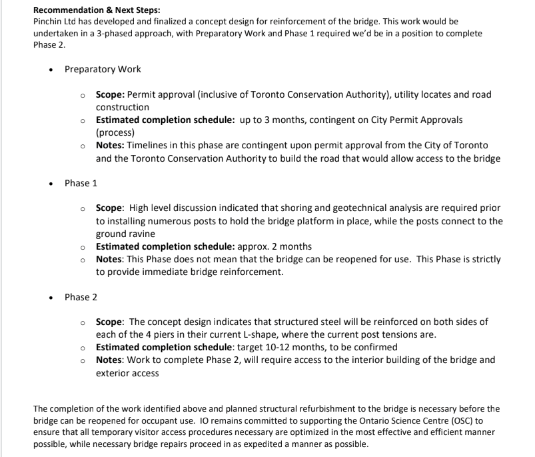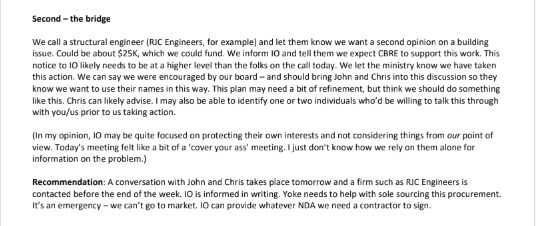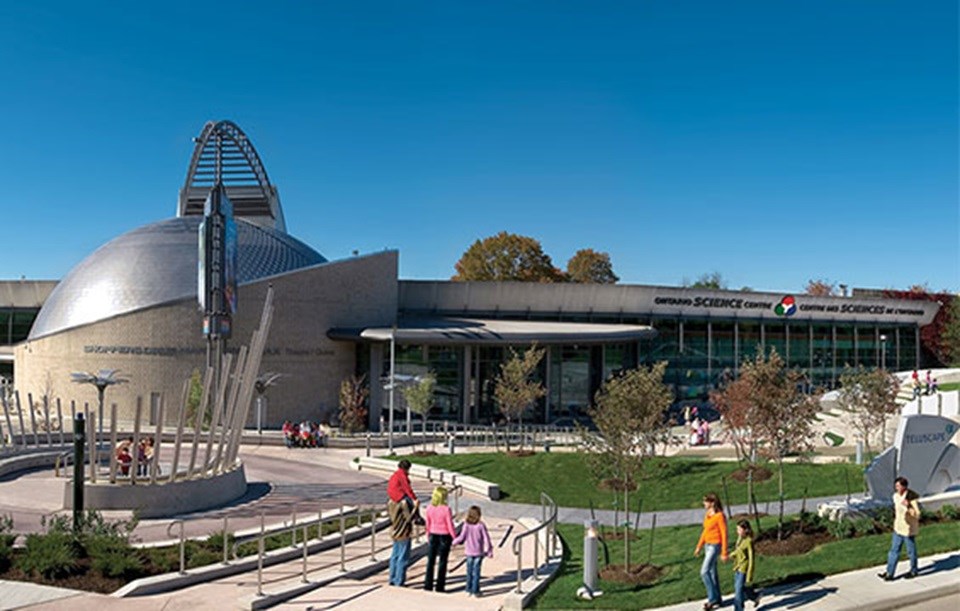EDITOR’S NOTE: This article originally appeared on The Trillium, a Village Media website devoted exclusively to covering provincial politics at Queen’s Park
As the leadership of the Ontario Science Centre scrambled to manage the sudden closure of the building's key bridge two years ago, one vice president was skeptical about the government's rationale and sought a second opinion, emails show.
Her efforts were ultimately unsuccessful. Six weeks ago — two years after access to the pedestrian bridge leading from its main entrance to the rest of the building was shut down — the 55-year-old Ontario Science Centre was closed to the public, possibly for good. There has been broad public skepticism of the government’s reasons for the total closure of the building.
The bridge’s closure on June 3, 2022, was an early trickle in a stream of developments leading to its indefinite closure. Using a freedom-of-information request, The Trillium obtained science centre executives’ emails from the week after. The emails offer new glimpses into their efforts to subdue the chaos the bridge’s closure created, how their thoughts varied on the decision, and how one vice president tried desperately to find a solution.
Closing time
Following a routine building assessment it conducted for Infrastructure Ontario in 2021, commercial real estate services firm CBRE reported to the science centre in January 2022 that it had found “a couple of cracks” and a leak in its pedestrian bridge, a briefing note prepared for board members about its closure said.
As a result, CBRE recommended a “more detailed structural investigation,” and that its use be limited to pedestrian foot traffic only, the June 2022 briefing note said.
In mid-April 2022, CBRE told the science centre that consultant engineers would conduct an onsite investigation.
Structural investigation work found on April 26, 2022, that the bridge’s cast-in-place concrete walls were “showing significant signs of cracking on the north elevation below the windows,” Ontario’s auditor general wrote in a December 2023 report.
Late in the afternoon of Friday, June 3, 2022, a CBRE representative “telephoned the (Science) Centre to convey the direction from (the consulting company) Pinchin to close the bridge,” while it finished its investigation over the next week, the briefing note prepared for board members said.
Execs scramble
The Ontario Science Centre’s leadership team, including its CEO and VPs, held an emergency meeting within an hour of CBRE relaying the bad news, emails show.
Late the next morning, Paul Kortenaar, CEO of the science centre, emailed board members informing them of the shutdown of the bridge “until further notice,” the centre’s temporary closure, and the intention to reopen on Wednesday, June 8, 2022.
The bridge’s closure was expected to hurt attendance significantly. Shuttle services to an alternative entrance would be costly as well. Science centre staff worked quickly in the days that followed to preserve access to the facility and most of its exhibitions.
On the evening of Tuesday, June 7, 2022, Infrastructure Ontario’s then-director of real estate operations emailed a group, including science centre and Infrastructure Ontario officials and CBRE representatives, to provide an update.
IO was informed “that a high potential risk of failure of the supporting steel tendons (located within supporting concrete) presently exists; and that a failure of these tendons will pose a safety risk to the bridge structure,” wrote Marie Tatarka in a June 7, 2022 email.
By then, Pinchin had “developed and finalized a concept design for reinforcement of the bridge,” Tatarka added. She outlined a three-phase approach, estimating it could be completed in 17 months.

Yoke Chung, the science centre’s chief operating officer, was forwarded Tatarka’s email an hour later. She then shared it with the centre’s CEO and VPs, adding, “Not good.”
Catherine Paisley, another Ontario Science Centre VP, looked for another solution, as an email thread between her Kortenaar, the centre’s CEO, from June 8, 2022, shows.
“I think we should seriously consider getting a second opinion on the state of the bridge and the work/remediation needed,” Paisley wrote to Kortenaar that afternoon in an email.
“This isn’t a matter of not trusting IO, it’s rather doing our due diligence with respect to something that is impacting us immediately and daily,” she said in the same email.
In another email soon after, Paisley wrote to Kortenaar, “We will need to be careful with this as we do not want to trigger a 'just shut down' response from anyone.”
“Let me think about how to move this along and who we could talk to off the record (for now) for some advice on both approach w/ IO and the Ministry and a second opinion on the actual problem,” Paisley wrote. “This is not business as usual and may need some bold and creative next steps. I think IO cares about this but I don't think they care about it the same way we do and I'm uncomfortable relying on them for how this proceeds.”
“Understood. Thank you so much for the advice. I look forward to hearing how we might proceed,” Kortenaar responded.
Late that evening, Paisley sent a lengthy email, proposing plans of her own to address the science centre’s newfound operational challenges, its bridge closure, and longer-term obstacles.
She proposed getting the science centre’s trustees on board to use $25,000 from its budget to quickly hire another engineering firm to assess the bridge, suggesting they be contacted before the end of the week. “It’s an emergency — we can’t go to market,” Paisley wrote.
“In my opinion, IO may be quite focused on protecting their own interests and not considering things from our point of view,” she wrote. “Today’s meeting felt like a bit of a ‘cover your ass’ meeting. I just don’t know how we rely on them alone for information on the problem.”

“I’m not sure if these are the right recommendations or not, but my gut is we cannot continue the way we are… We have to demonstrate to the ministry that we can operate for the next 17+ months in a responsible way,” Paisley added. “The board will likely expect this too. We can’t give them any reason to call out our sustainability.”
Also that evening, Kortenaar wrote back that while he thought “many of (Paisley’s) suggestions and cautions are valid” that he didn’t “understand the second engineering opinion however."
“What can we hear? If our engineer suggested the bridge closure was an overreaction, what then? Do we accept liability?” he continued in his response.
The CEO and VP also agreed to chat the following morning of the next day: Thursday, June 9, 2022.
The next morning, an architect from another company helped put Paisley in touch with a pair of principals of RJC Engineers, who she’d mentioned to Kortenaar as an option, emails show.
The Trillium attempted to reach Paisley at her listed Ontario Science Centre phone number and email address on Wednesday but didn’t hear back from her before the publication of this story.
The science centre’s pedestrian bridge never reopened after June 3, 2022.
The land the science centre's now-closed building is on is leased from the City of Toronto and Toronto and Region Conservation Authority (TRCA). Steve Heuchert, the TRCA's associate director of development and engineering services, said in a statement on Wednesday TRCA was "originally contacted by Infrastructure Ontario regarding permitting requirements for Ontario Science Centre pedestrian bridge repairs in Fall 2022, which were provided, but ultimately this work was put on hold by IO."
RJC Engineers was eventually hired to investigate the pedestrian bridge, but by Infrastructure Ontario, not the Ontario Science Centre itself.
"RJC is currently contracted by IO to complete an investigation of the pedestrian bridge," Ian McConachie, spokesperson for Infrastructure Ontario, wrote in an email on Wednesday. "We expect a draft report to be provided later this year."
"In May 2024, TRCA was contacted by (RJC), on behalf of IO, to implement scaffolding in order for an inspection to be conducted on the pedestrian bridge... and clearance was granted to proceed," Heuchert said.
The business case comparing repairing to relocating the science centre that was submitted to Infrastructure Ontario in early March 2023 said a “preliminary estimate” of the cost of fixing the pedestrian bridge was $16 million. Although the business case also said that “detailed engineering and costing for bridge repair are expected in late March 2023,” they haven't been since.
Briefing materials that Infrastructure Ontario has released over the last couple of months have also said the bridge has continued to be investigated. Because it's over a ravine, “standard construction costing is not applicable” to estimate the cost of repairing it, said Infrastructure Ontario in a July 11 presentation. The agency also said a few weeks ago that other repairs, like fixing heating in part of the overall building, wouldn’t be able to be completed until the bridge is fixed.
"The full extent of the condition of the pedestrian bridge is continuing to be investigated," Infrastructure Ontario's spokesperson added on Wednesday. "Once the RJC report is received and reviewed, we will have a more comprehensive understanding of the structural concerns with the pedestrian bridge as well as possible repairs options and how long those might take."
While it works toward building a new science centre at Ontario Place, the Ford government hopes to relocate it to a temporary home, which it's currently looking for.
Editor's note: This story was updated at 5:33 p.m. on Wednesday, July 31 to include comments from Steve Heuchert, of the Toronto and Region Conservation Authority.
Correction: This story was updated at 7:09 a.m. on Thursday, Aug. 1 to properly refer to Yoke Chung as "she," rather than "he," as was previously written.
